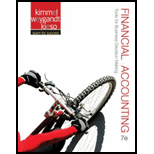
(a)
Accounting cycle refers to the process of recording, posting, and preparing financial statements of a company. It shows the processing of the financial transactions in sequence that starts from occurrence of the transactions and ends with the preparation of financial statements.
To Explain: Whether the steps in accounting cycle for a merchandising company differs from the steps in the accounting cycle for a service company.
(a)
Answer to Problem 1Q
No, the steps in accounting cycle for a merchandising company does not differ from the steps in the accounting cycle for a service company.
Explanation of Solution
The steps in the accounting cycle that is same for both Merchandise Company, and Service Company are stated below:
- Analyze and record transactions in the journal.
Post the journals entries to the ledger (T-accounts).- Prepare a
trial balance . - Prepare financial statements.
- Prepare closing entries.
(b)
To Explain: Whether the measurement of net income in a merchandising company conceptually the same as in a service company.
(b)
Answer to Problem 1Q
Yes, the measurement of net income in a merchandising company is conceptually same as in a service company.
Explanation of Solution
The net income in both the companies is derived by deducting all the expenses from the total revenue earned during a year.
Want to see more full solutions like this?
Chapter 5 Solutions
Financial Accounting
- Quick answer of this accounting questionsarrow_forwardBlockbuster Co is building a new state of the art cineplex at a cost of $3,500,000.They received a capital investment of $1,500,000. The remainder of funds will haveto be borrowed so they decided to issue bonds. They have issued 10.5%, 5-yearbonds. These bonds were issued on January 1st, 2020, and pay semi-annual intereston July 1st and January 1st. The bonds yield 10%. The year end is December 31st Calculate the proceeds from the sale of the bond. Clearly show theamount of the premium or discount and state two reasons which supportthe premium or discount calculatedarrow_forwardGeneral accounting questionarrow_forward
- Need help with this question solution general accountingarrow_forwardBlockbuster Co is building a new state of the art cineplex at a cost of $3,500,000.They received a capital investment of $1,500,000. The remainder of funds will haveto be borrowed so they decided to issue bonds. They have issued 10.5%, 5-yearbonds. These bonds were issued on January 1st, 2020, and pay semi-annual intereston July 1st and January 1st. The bonds yield 10%. The year end is December 31starrow_forwardHi expert please give me answer general accounting questionarrow_forward
- General Accountingarrow_forwardRequired Determine whether the following items included in Wong Company’s January Year 1 bank reconciliation will require adjusting or correcting entries on Wong’s books. When an entry is required, record it in general journal format. Note: If no entry is required for a transaction or event, select "No journal entry required" in the first account field. Service charges of $50 for the month of January were listed on the bank statement. The bank charged a $250 check drawn on Wing Restaurant to Wong’s account. The check was included in Wong’s bank statement. A check of $62 was returned to the bank because of insufficient funds and was noted on the bank statement. Wong received the check from a customer and thought it was good when it was deposited into the account. A $990 deposit was recorded by the bank as $980. Four checks totaling $810 written during the month of January were not included with the January bank statement. A $75 check written to OfficeMax for office supplies was…arrow_forwardTotal assets at the year end?arrow_forward
- Please give me true answer this financial accounting questionarrow_forwardcritically analyze the effectiveness of the tax system in Jamaica with a brief history of the tax system highlight the different types of taxes used in the country and identify and discuss 4 problems with the Jamaican tax system.arrow_forwardSolve my problemarrow_forward
 College Accounting (Book Only): A Career ApproachAccountingISBN:9781337280570Author:Scott, Cathy J.Publisher:South-Western College PubPrinciples of Accounting Volume 2AccountingISBN:9781947172609Author:OpenStaxPublisher:OpenStax College
College Accounting (Book Only): A Career ApproachAccountingISBN:9781337280570Author:Scott, Cathy J.Publisher:South-Western College PubPrinciples of Accounting Volume 2AccountingISBN:9781947172609Author:OpenStaxPublisher:OpenStax College Managerial AccountingAccountingISBN:9781337912020Author:Carl Warren, Ph.d. Cma William B. TaylerPublisher:South-Western College Pub
Managerial AccountingAccountingISBN:9781337912020Author:Carl Warren, Ph.d. Cma William B. TaylerPublisher:South-Western College Pub Principles of Cost AccountingAccountingISBN:9781305087408Author:Edward J. Vanderbeck, Maria R. MitchellPublisher:Cengage Learning
Principles of Cost AccountingAccountingISBN:9781305087408Author:Edward J. Vanderbeck, Maria R. MitchellPublisher:Cengage Learning



